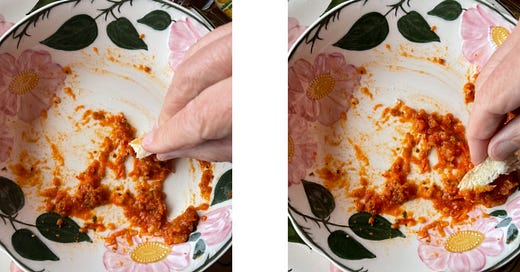By Carlotta Panza. Originally published on Italy Segreta in July 2021.
Fare la scarpetta is the act of tearing a chunk of bread off of a loaf, pinching it between your right thumb and index finger, and dragging it around an almost-empty plate–often of pasta–which still has dollops of sauce. Once the piece of bread is sufficiently coated with sauce, it is lifted and gobbled up in order to savour every last bit.
Sometimes, when I find myself in an intimate context with friends away from the public eye, I consider licking my fingers as a way of completing la scarpetta. Like the famous Fonzies’ cheese chip ad declares: “Se non ti lecchi le dita, godi solo a metà!” (“If you don’t lick your fingers, you only get half of the pleasure!”)
La scarpetta literally translates to “the little shoe”, and a shoe is, in fact, where its name originates from. Like a shoe being dragged across the floor, la scarpetta mirrors the same action–though, unlike a shoe, it leaves the dish spotless.
There is no finer compliment to one’s cuisine than a plate that has been fully and enthusiastically cleaned. This simple act is one of the many nonverbal forms of communication we Italians practise on a daily basis to express appreciation not only for food, but also for the person who took the time to feed us.
I have been to countless dinners where we reach an often, albeit brief, competitive moment: who will get the privilege of doing la scarpetta of the serving bowl? At home, we’re not afraid to all stick our pieces of bread into the communal dish together. But, in more formal situations, we have to consider il galateo (the etiquette), a touchy subject in Italian dining culture, especially for older generations. Published in 1558, the stringent rules put forth by the Galateo overo de’ costumi are still fiercely upheld by most Italians Gen X and up: you must sit upright and never lean against the back of the chair; you must wait to eat until after the head of the table has begun; and, it almost goes without saying, you must never (ever!) rest your elbows on the table.
It may come as no surprise that, according to the galateo, fare la scarpetta is absolutely forbidden, partly because it involves using one’s hands to touch food, but also because it’s a gesture historically associated with poverty, famine, and war. Standards of appropriate behaviour have loosened over the decades, however, as people have generally transitioned to a more informal way of life; only relatively recently has it been appropriate to snack on bread before or after a meal and in between courses.
I happily throw the galateo to the wind when I come across a good scarpetta, which relies on two factors: sugo (sauce) and bread. If the sauce isn’t good, doing la scarpetta isn’t even taken into consideration–no one wants to finish bad sauce. Likewise, if the bread is dry or flavourless, most people don’t feel like eating more of it; although, if the sauce is exceptional, even bad bread can’t stop la scarpetta.
For those rare dishes that forgo sugo, olive oil or melted butter–depending on where in Italy you find yourself–is a must. Even the simplest condiment like freshly pressed, bright green olive oil with its peppery flavour makes for a great scarpetta; its beauty lies in its simplicity, pure and real.
No wonder the galateo forbids la scarpetta: in essence, la scarpetta is a glorified way to lick your plate. Whether you’re capturing the last dregs of a Ligurian pesto or a Sicilian norma, all you need is bread, sugo, and an enthusiastic appreciation for food–three ingredients that can be found anywhere in this country.






I was once told to use a fork when in polita company. Somehow it isn't quite as satisfying..
Thank you Carlotta for this wonderful post. I think “La Scarpetta” would be a fantastic name for a Substack.